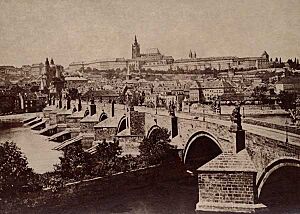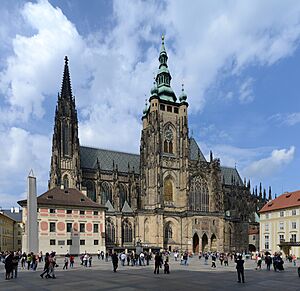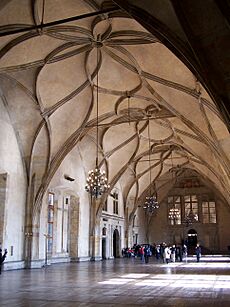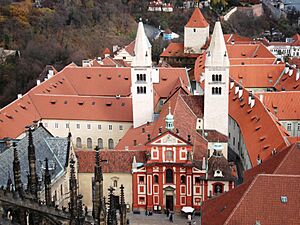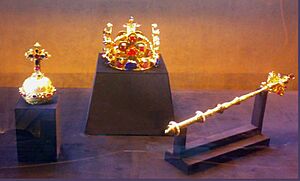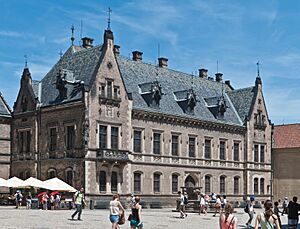Prague Castle facts for kids
Quick facts for kids Prague Castle |
|
|---|---|
|
Pražský hrad
|
|

Prague Castle
|
|
| General information | |
| Architectural style | Baroque, Mannerism |
| Location | Prague 1, Prague, Czech Republic |
| Coordinates | 50°5′24″N 14°24′0″E / 50.09000°N 14.40000°E |
| Current tenants | Petr Pavel (2023–present) |
| Construction started | 870 |
| Design and construction | |
| Architect | Matthias of Arras, Peter Parler |
Prague Castle (Czech: Pražský hrad) is a huge castle complex in Prague, Czech Republic. It is the official home and workplace of the president of the Czech Republic.
This amazing castle was built way back in the 9th century. For centuries, it was the main place of power for kings of Bohemia, Holy Roman emperors, and later, presidents of Czechoslovakia. Because of its important role, people often use "Prague Castle" or just "the Castle" to refer to the president and their team.
Did you know that the Bohemian Crown Jewels are kept in a secret room inside the castle? These are very old and valuable treasures!
According to the Guinness Book of Records, Prague Castle is the largest ancient castle in the world. It covers an area of almost 70,000 square meters (about 750,000 square feet). It's about 570 meters (1,870 feet) long and about 130 meters (427 feet) wide. It's one of the most popular tourist attractions in Prague, with over 1.8 million visitors every year!
Contents
History of Prague Castle
Early Beginnings: The Přemyslid Fort
The story of Prague Castle started in the year 870. This is when its first walled building, the Church of the Virgin Mary, was built. Later, in the early 10th century, two more important churches were founded: the Basilica of Saint George and the Basilica of St. Vitus. These were built under the rule of Vratislaus I, Duke of Bohemia and his son St. Wenceslaus.
The very first convent in Bohemia was also built here, right next to St. George's church. In the 12th century, a beautiful Romanesque palace was added to the castle complex.
The Medieval Castle Era
In the 13th century, King Ottokar II of Bohemia made the castle stronger. He also rebuilt the royal palace to be more grand for important events and for living. In the 14th century, under Emperor Charles IV, the royal palace was rebuilt again, this time in the Gothic style. The castle's defenses were also made even stronger.
During this time, work began on a huge Gothic church, the St. Vitus Cathedral. It took almost six centuries to finish!
After the Hussite Wars, the castle was empty for many years. But in 1485, King Vladislaus II Jagiellon started rebuilding it. The massive Vladislav Hall was added to the Royal Palace. New defense towers were also built on the north side of the castle.
A big fire in 1541 damaged much of the castle. Later, under the Habsburgs, new buildings were added in the Renaissance style. For example, Ferdinand I built the Belvedere as a summer palace for his wife. Rudolph II made Prague Castle his main home. He added the northern part of the palace, including the Spanish Hall, where he showed off his amazing art collections.
In 1618, a famous event called the Third Defenestration of Prague happened at the castle. This event helped start a big conflict known as the Thirty Years' War. During these wars, the castle was damaged. Many artworks from Rudolph II's collection were taken by Swedish soldiers in 1648.
The last major rebuilding of the castle happened in the late 1700s, led by Empress Maria Theresa. After he gave up his throne in 1848, former emperor Ferdinand I made Prague Castle his home.
Prague Castle as a Presidential Residence
In 1918, a new country called the First Czechoslovak Republic was formed. Prague Castle then became the home of its first president, Tomáš Masaryk. The New Royal Palace and the gardens were updated by a famous architect named Jože Plečnik. The St. Vitus Cathedral was finally completed in 1929.
During World War II, when Nazi Germany occupied Czechoslovakia, Adolf Hitler visited Prague Castle. Later, Reinhard Heydrich, a high-ranking Nazi official, made the castle his headquarters. There's a popular story that he wore the Bohemian crown. An old legend says that anyone who illegally wears the crown will die within a year. Less than a year after taking power, Heydrich was attacked and died from his injuries.
After the war and a change in government in 1948, the castle became the offices for the communist government of Czechoslovakia. When Czechoslovakia split into the Czech Republic and Slovakia in 1993, Prague Castle became the home of the President of the new Czech Republic. President Václav Havel asked architect Bořek Šípek to make new improvements to the castle, including updating its art gallery.
Architectural Styles and What to See
Prague Castle is like a living history book of architecture! Its buildings show off many different styles from the last thousand years. You can see Gothic buildings like the amazing St Vitus Cathedral. There's also the Romanesque Basilica of St. George, a monastery, several palaces, beautiful gardens, and old defense towers.
Most parts of the castle are open for visitors to explore. Inside, you'll find several museums. These include a collection of Bohemian baroque and Mannerist art, an exhibition about Czech history, a Toy Museum, and a picture gallery with art from Rudolph II's collection. You might even catch the Summer Shakespeare Festival in the courtyard of the Burgrave Palace!
The area right around Prague Castle is called Hradčany.
Important Buildings at Prague Castle
Here are some of the main buildings and areas you can find at Prague Castle:
- Churches:
- Katedrála svatého Víta, Václava a Vojtěcha (St. Vitus Cathedral) - The biggest and most famous church.
- Bazilika svatého Jiří (St. George's Basilica, Prague) and Klášter svatého Jiří (St. George's Convent, Prague) - The oldest church building still standing in the castle.
- Chrám Všech svatých (All Saints Church)
- Kaple svatého Kříže (Holy Cross Chapel)
- Palaces:
- Starý královský palác (Old Royal Palace)
- Letohrádek královny Anny (Queen Anne's Summer Palace, also known as the Belvedere)
- Lobkovický palác (Lobkowicz Palace)
- Nový královský palác (New Royal Palace (Prague))
- Halls:
- Sloupová síň (Column Hall)
- Španělský sál (Spanish Hall)
- Rudolfova galerie (Rudolph's Gallery)
- Vladislavský sál (Vladislav Hall) - A huge hall used for important events.
- Towers:
- Bílá věž (White Tower (Prague Castle))
- Černá věž (Black Tower (Prague Castle))
- Daliborka (Dalibor Tower)
- Prašná věž or Mihulka (Mihulka)
- Other Interesting Buildings:
- Zlatá ulička (Golden Lane) - A charming street with tiny, colorful houses.
- Staré purkrabství (Old Supreme Burgrave's House)
- Míčovna (Ball Game Hall)
- Jízdárna Pražského hradu (Riding School)
- Obrazárna Pražského hradu (Picture Gallery of the Prague Castle)
- Gardens:
- Královská zahrada (Royal Garden of Prague Castle)
- Zahrada na terase Jízdárny (Riding School Terrace Garden)
- Jižní zahrady (South Gardens)
- Jelení příkop (Deer Moat)
- Svatováclavská vinice (St. Wenceslas vineyard)
- Structures:
- Kohlova kašna (Kohl's Fountain)
- Matyášova brána (Matthias Gate)
- Prague Castle Obelisk
- Socha svatého Jiří (Statue of Saint George)
See also
- History of early modern period domes
- Prague Castle skeleton



